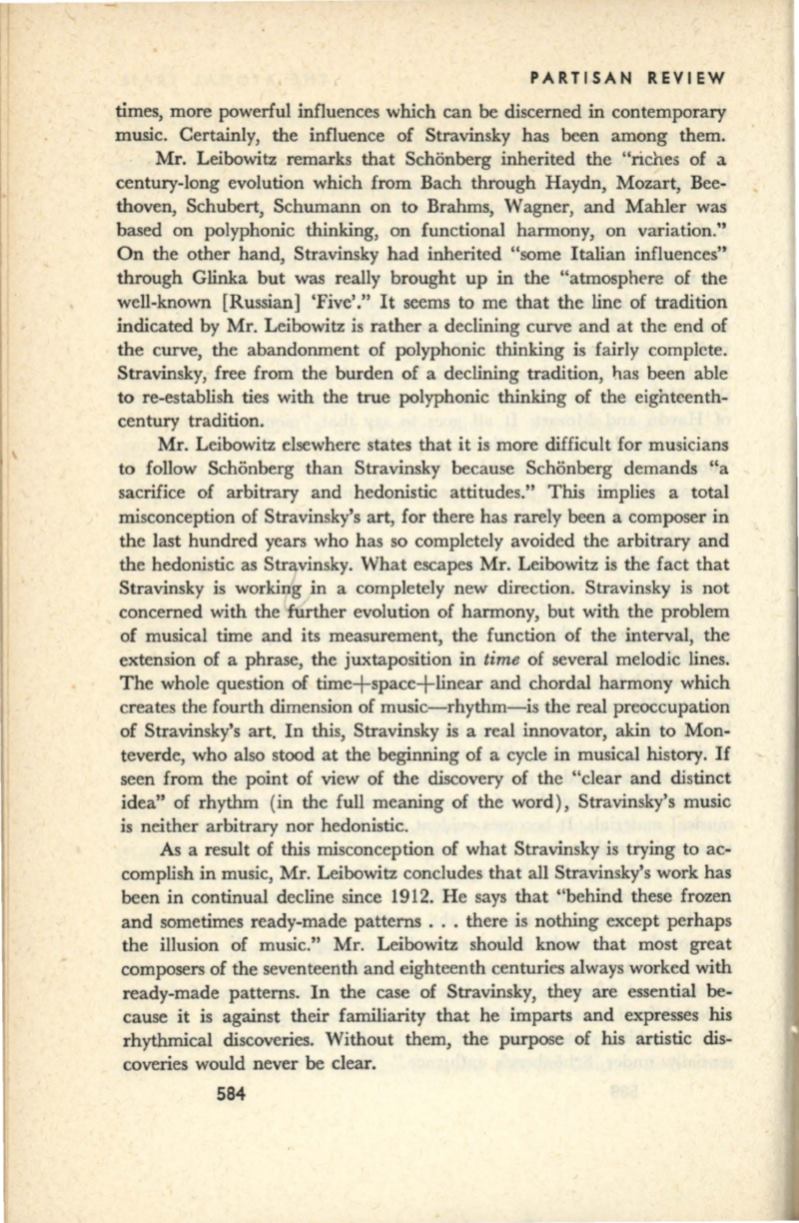
PARTISAN REVIEW
times, more powerful influences which can be discerned in contemporary
music. Certainly, the influence of Stravinsky has been among them.
Mr. Leibowitz remarks that Schonberg inherited the "riches of a
century-long evolution which from Bach through Haydn, Mozart, Bee–
thoven, Schubert, Schumann on to Brahms, Wagner, and Mahler was
based on polyphonic thinking, on functional harmony, on variation."
On the other hand, Stravinsky had inherited "some Italian influences"
through Glinka but was really brought up in the "atmosphere of the
well-known [Russian] 'Five'." It seems to me that the line of tradition
indicated by Mr. Leibowitz is rather a declining curve and at the end of
the curve, the abandonment of polyphonic thinking is fairly complete.
Stravinsky, free from the burden of a declining tradition, has been able
to re-establish ties with the true polyphonic thinking of the eighteenth–
century tradition.
Mr. Leibowitz elsewhere states that it is more difficult for musicians
to follow Schonberg than Stravinsky because Schonberg demands "a
sacrifice of arbitrary and hedonistic attitudes." This implies a total
misconception of Stravinsky's art, for there has rarely been a composer in
the last hundred years who has so completely avoided the arbitrary and
the hedonistic as Stravinsky. What escapes Mr. Leibowitz is the fact that
Stravinsky is working in a completely new direction. Stravinsky is not
concerned with the further evolution of harmony, but with the problem
of musical time and its measurement, the function of the interval, the
extension of a phrase, the juxtaposition in
time
of several melodic lines.
The whole question of time+space+linear and chordal harmony which
creates the fourth dimension of music-rhythm-is the real preoccupation
of Stravinsky's art. In this, Stravinsky is a real innovator, akin to Mon–
teverde, who also stood at the beginning of a cycle in musical history.
If
seen from the point of view of the discovery of the "clear and distinct
idea" of rhythm (in the full meaning of the word), Stravinsky's music
is neither arbitrary nor hedonistic.
As a result of this misconception of what Stravinsky is trying to ac–
complish in music, Mr. Leibowitz concludes that all Stravinsky's work has
been in continual decline since 1912. He says that "behind these frozen
and sometimes ready-made patterns ... there is nothing except perhaps
the illusion of music." Mr. Leibowitz should know that most great
composers of the seventeenth and eighteenth centuries always worked with
ready-made patterns. In the case of Stravinsky, they are essential be–
cause it is against their familiarity that he imparts and expresses his
rhythmical discoveries. Without them, the purpose of his artistic dis–
coveries would never be clear.
584


